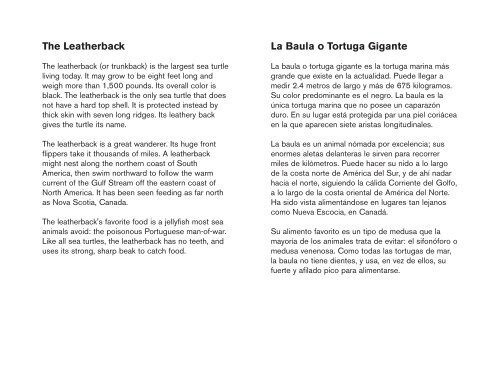Sea Turtles - WIDECAST
Sea Turtles - WIDECAST
Sea Turtles - WIDECAST
- No tags were found...
You also want an ePaper? Increase the reach of your titles
YUMPU automatically turns print PDFs into web optimized ePapers that Google loves.
The LeatherbackThe leatherback (or trunkback) is the largest sea turtleliving today. It may grow to be eight feet long andweigh more than 1,500 pounds. Its overall color isblack. The leatherback is the only sea turtle that doesnot have a hard top shell. It is protected instead bythick skin with seven long ridges. Its leathery backgives the turtle its name.The leatherback is a great wanderer. Its huge frontflippers take it thousands of miles. A leatherbackmight nest along the northern coast of SouthAmerica, then swim northward to follow the warmcurrent of the Gulf Stream off the eastern coast ofNorth America. It has been seen feeding as far northas Nova Scotia, Canada.The leatherback's favorite food is a jellyfish most seaanimals avoid: the poisonous Portuguese man-of-war.Like all sea turtles, the leatherback has no teeth, anduses its strong, sharp beak to catch food.La Baula o Tortuga GiganteLa baula o tortuga gigante es la tortuga marina másgrande que existe en la actualidad. Puede llegar amedir 2.4 metros de largo y más de 675 kilogramos.Su color predominante es el negro. La baula es laúnica tortuga marina que no posee un caparazónduro. En su lugar está protegida par una piel coriáceaen la que aparecen siete aristas longitudinales.La baula es un animal nómada por excelencia; susenormes aletas delanteras le sirven para recorrermiles de kilómetros. Puede hacer su nido a lo largode la costa norte de América del Sur, y de ahí nadarhacia el norte, siguiendo la cálida Corriente del Golfo,a lo largo de la costa oriental de América del Norte.Ha sido vista alimentándose en lugares tan lejanoscomo Nueva Escocia, en Canadá.Su alimento favorito es un tipo de medusa que lamayoría de los animales trata de evitar: el sifonóforo omedusa venenosa. Como todas las tortugas de mar,la baula no tiene dientes, y usa, en vez de ellos, sufuerte y afilado pico para alimentarse.
















